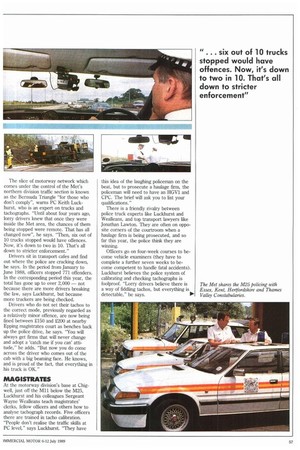CANID
Page 58

Page 59

If you've noticed an error in this article please click here to report it so we can fix it.
CAINCIRA
• Police on one of Britain's busiest stretches of motorway are using video cameras to trap speeding truckers and manic motorists. The equipment, which so far has been fitted to two Metropolitan Police motorway patrol cars, films offenders and has been used as evidence in court.
Now, the Met plans to fit the Provida system into more cars, some possibly unmarked, in its war against dangerous driving on a notorious section of the M25 between the AIM and M11, known as the Bermuda Triangle.
PC Les Crossland, who is responsible for training officers to use Provida and other speed-checking equipment, refutes claims that the hidden cameras, introduced three years ago, reflect a Big Brother attitude. "We don't only use it for enforcement: we use it for education too," he says. "The last thing I want to do is come along in my car and have to scrape people off the motorway."
Offenders, whether they are penalised or simply given a warning, are invited into the squad car to look at a recording of their bad driving. Some drivers are shocked to see how bad their motorway behaviour is.
The film is also admissible in court. In the first test case using Provida evidence a year ago, a motorcycle dispatch rider was fined 2300 with 2300 costs for reckless driving.
EQUIPMENT
A 26,000 Provida unit comprises a detatchable camera fitted to the top of the windscreen, a monitor and a video data generator box. Several other forces, including West Midlands and Suffolk, now use Provida or similar equipment.
It is not meant for covert operations, says Crossland — he did expect allegations of 1984-type police operations when Provida was installed three years ago, but has not received any yet.
The Met also uses a helicopter which patrols the M25 to pinpoint speeders. Some drivers are impressed when they find that they have been detected by an airborne patrol, he says. "It gives them something to talk about, being among the few to be stopped this way." The West German police use hidden cameras fitted to gantries which spot speeding drivers, after which computers send instant summonses or fines to registered owners of the vehicles. Crossland does not think that system would be acceptable here. "That does seem a bit too much like Big Brother," he says. The slice of motorway network which comes under the control of the Met's northern division traffic section is known as the Bermuda Triangle "for those who don't comply", warns PC Keith Luckhurst, who is an expert on trucks and tachographs. "Until about four years ago, lorry drivers knew that once they were inside the Met area, the chances of them being stopped were remote. That has all changed now", he says. "Then, six out of 10 trucks stopped would have offences. Now, it's down to two in 10. That's all down to stricter enforcement."
Drivers sit in transport cafes and find out where the police are cracking down, he says. In the period from January to June 1988, officers stopped 771 offenders. In the corresponding period this year, the total has gone up to over 2,000 — not because there are more drivers breaking the law, says Luckhurst, but because more truckers are being checked.
Drivers who do not set their tachos to the correct mode, previously regarded as a relatively minor offence, are now being fined between £150 and £200 at nearby Epping magistrates court as benches back up the police drive, he says. "You will always get firms that will never change and adopt a 'catch me if you can' attitude," he adds. "But now you do come across the driver who comes out of the cab with a big beaming face. He knows, and is proud of the fact, that everything in his truck is OK."
MAGISTRATES
At the motorway division's base at Chigwell, just off the M11 below the M25, Luckhurst and his colleagues Sergeant Wayne Wealleans teach magistrates' clerks, fellow officers and others how to analyse tachograph records. Five officers there are trained in tacho calibration. "People don't realise the traffic skills at PC level," says Luckhurst. "They have this idea of the laughing policeman on the beat, but to prosecute a haulage firm, the policeman will need to have an HGV1 and CPC. The brief will ask you to list your qualifications."
There is a friendly rivalry between police truck experts like Luckhurst and Wealleans, and top transport lawyers like Jonathan Lawton. They are often on opposite corners of the courtroom when a haulage firm is being prosecuted, and so far this year, the police think they are winning.
Officers go on four-week courses to become vehicle examiners (they have to complete a further seven weeks to become competent to handle fatal accidents). Luckhurst believes the police system of calibrating and checking tachographs is foolproof. "Lorry drivers believe there is a way of fiddling tachos, but everything is detectable," he says.




















































































































